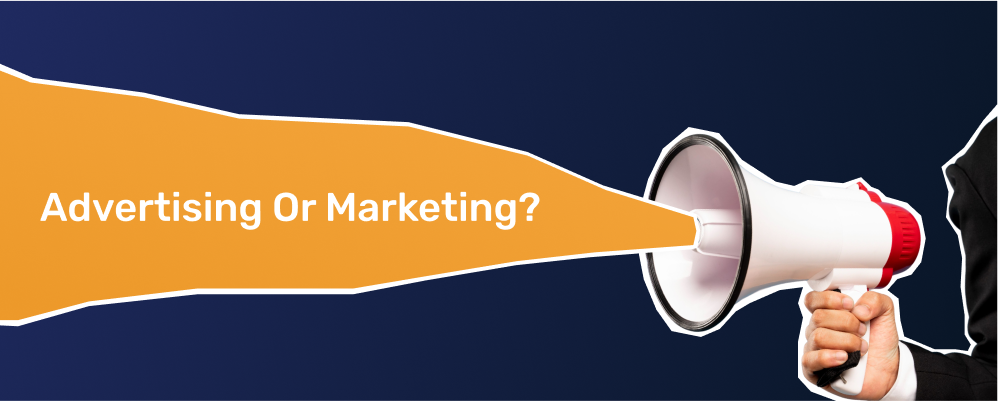Why Marketing and Advertising Are Two Different Things

Hello, hello!
You’re reading the fifth article in the “MythBusters” series, where we take apart popular myths about marketing practices. We have already destroyed the ones about marketing automation, SMS marketing, other people’s marketing strategies, and automated services for customer support. Now, it’s time for another myth — “Advertising and marketing are the same.”
As always, let’s explore its origin first.
Origins of the myth
If you know the person who came up with this myth, get in touch with us, and we’ll give you an “Ultimate MythBuster” badge. But as we have yet to discover its exact origins, we can only guess based on the most common misleading conclusions.
We know that marketing and advertising are NOT the same (and we’ll tell you why in a minute). But let’s just listen to the arguments in favor of this myth to try and understand where it stems from.
“The purpose of marketing and advertising is to sell, so they are the same.”
This point seems pretty logical: people see attractive ads and buy the products they promote. So, in the minds of believers in this myth, the main goal of advertising and marketing is to sell the company’s products or services. Hence, they are the same.
They may not know, however, that the actual goal of marketing is to inform, persuade, and remind the target audience about the products or services a business offers.
Strike one.
“Advertising and marketing use the same channels — I see ads on Instagram all the time, and all marketers go wild about SMM.”
True, our digital feeds are flooded with ads. Just forget to go Incognito once when googling a present for a friend, and the ads of extra large unicorn pajamas will stalk you for weeks.
Marketers also use social media all the time, and if you google the job responsibilities of an SMM manager, you’ll likely find “running advertising campaigns” among them.
But this absolutely doesn’t mean that advertising and marketing are synonymous since they use the same channels. And if you look closely, you’ll notice that only some channels are used by both (keep reading to discover them).
Strike two.
“Advertising and marketing use the same techniques, like collecting customer data for personalization.”
And? That doesn’t make them the same thing.
Of course, marketing and advertising are effective only when you know the pains of your target audience. So companies collect customer data and use it as a source of information. In the words of the Content Marketing Playbook, “Always map content to the customer’s pain point.”
Advertising also takes advantage of customers’ pains, which is the source of many commercials. Remember when Joey from Friends failed to open a milk carton without spilling?
So does that mean if marketing and advertising use the same techniques, there is no need to distinguish them? That’s a hard no.
Strike three. The myth is out!
What actually is going on: Differences between marketing and advertising
Do you remember the parable of the three blind men and an elephant? (We promise we’re going somewhere with this).
“Three blind men come across an elephant. The first man happens upon its leg and concludes it’s a tree. The second man bumps into its trunk and concludes it’s a snake. The last blind man feels its tail and concludes it’s a broom.”
The same goes with marketing and advertising — if you consider just some part of it, you miss the whole picture. So let’s take a step back and explore the differences.

Marketing vs. advertising: Goals and effect
The ultimate purpose of marketing and advertising is to boost the sales process. We won’t argue with that. But they do pursue specific goals.
Advertising aims to elicit a quick and desired response from customers by drawing their attention to a particular product or service. And if ads are successful, they make people remember your brand.
The goal of marketing is much broader. Marketing shapes the image of the company and its products through diverse methods, tools, and techniques, including market research, printed content, promotional events, and advertising. Marketing, too, helps generate sales but has a different effect — it builds awareness about the company and its products.
Marketing and advertising are like a runner, a swimmer, a cycler, and their coach in a triathlon relay. They all want to win a medal for the team, and athletes train hard to perform in their respective parts of the competition. Meanwhile, the coach holds the team together — and the team cannot win without one of the athletes. It needs all of them to succeed.
So, advertising is just one of the tools under the marketing umbrella.
Now, allow us to introduce some common marketing and advertising types, and you’ll see the difference.
Types of marketing and kinds of advertising
Let’s get the ball rolling with marketing. You can break it down into two types.
Traditional marketing and digital marketing
Traditional marketing includes ad placement on TV, radio, billboards, leaflets, newspapers or other print media. Basically, traditional marketing is any form of pre-digital marketing, i.e., marketing that uses offline media to reach an audience. Today, this type is never used as the one and only method.
Digital marketing covers all other types of promotion that use digital communication. Meaning brands use the internet to connect with their customers, applying approaches like:
Advertising could be considered a type of digital marketing, but companies still rely on conventional methods of publishing ads too. So, advertising falls somewhere between traditional and digital marketing. Let’s take a closer look at its types.
Advertising types
Advertising in marketing usually includes the following:
As you can see, some ad types, like video, can be distributed across all channels, while others, like print ads, are limited to one channel only. Advertising can be part of SMM, email, or content marketing campaigns.
Now, let’s go back to the idea of the same channels = the same things. Advertising is just one tool in a larger marketing toolkit, and its presence on social media doesn’t cover all marketing needs. Using the allegory of an elephant, we can say that advertising is not even the SMM’s foot — it’s just one of its toes.

Digital advertising vs. digital marketing: Collecting and using data
Finally, let’s talk about the difference between marketing and advertising in terms of techniques and methods, particularly customer data usage.
Again, we won’t argue that marketing and advertising need customer data for success. But what do they do once it’s collected?
Customer data gathered via cookies, surveys, and registration forms can be used for different marketing purposes:
Advertising as part of marketing needs data only for the first two goals. It is very helpful to know an average customer’s profile and interests to create an effective ad. Meanwhile, marketers use the same data to choose the most relevant product features, determine the optimal price, and find the best venue for its promotion. People who analyze this data don’t even need customers’ names, contacts, and other personal information — all they need is figures.
Sometimes, though, marketers do need personalized data, including names. That’s when they want to provide the most relevant recommendation with a personal touch to a specific customer. For example, send them an email with a personal greeting (“Hi, Jim!”) after they buy a bottle of sunscreen to share useful tips on how to protect the skin and what other skin care products to use.
So, sure, marketing and advertising collect and analyze customer data in a similar manner. But only to some point. Marketing techniques offer a much broader range of options, and advertising represents only a tiny fraction of the available strategies.
The myth is busted. What does this give you?
Now you know that marketing and advertising aren’t the same, and ads are only one tool in a large marketing toolkit. This, hopefully, means the following:
Finally, you’ll successfully attract and retain customers and finally become a lovemark.
But first, you should double-check that you and your team don’t believe in other marketing myths. Retainly and its MythBusters series are here for you.